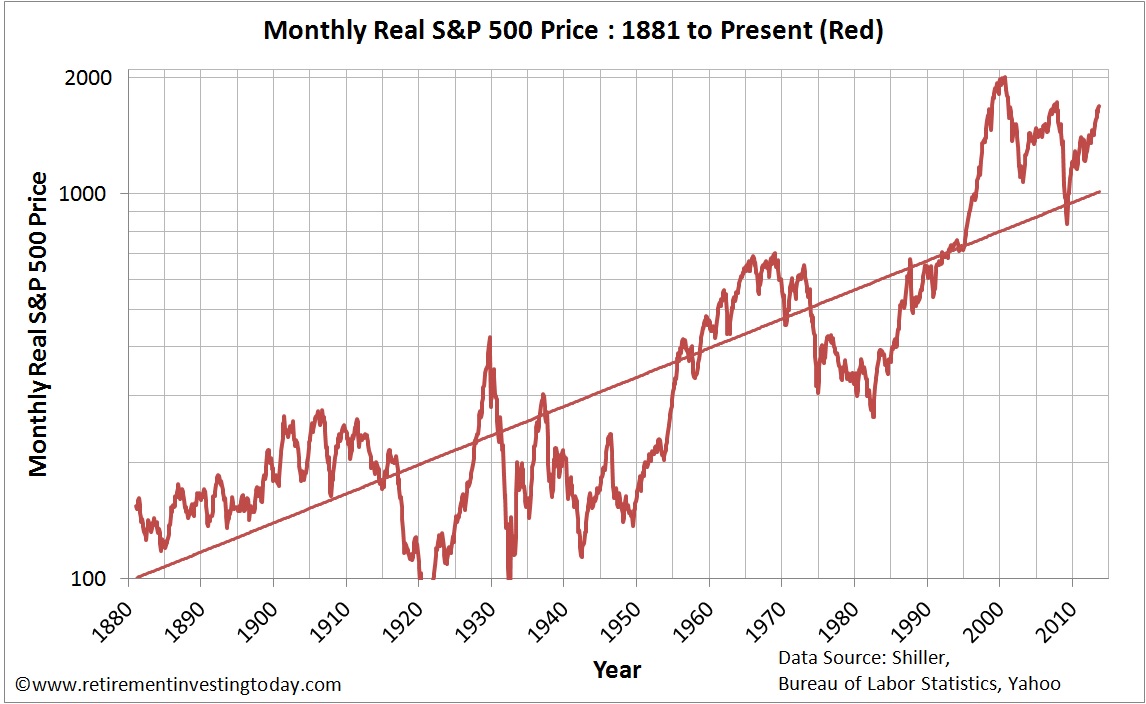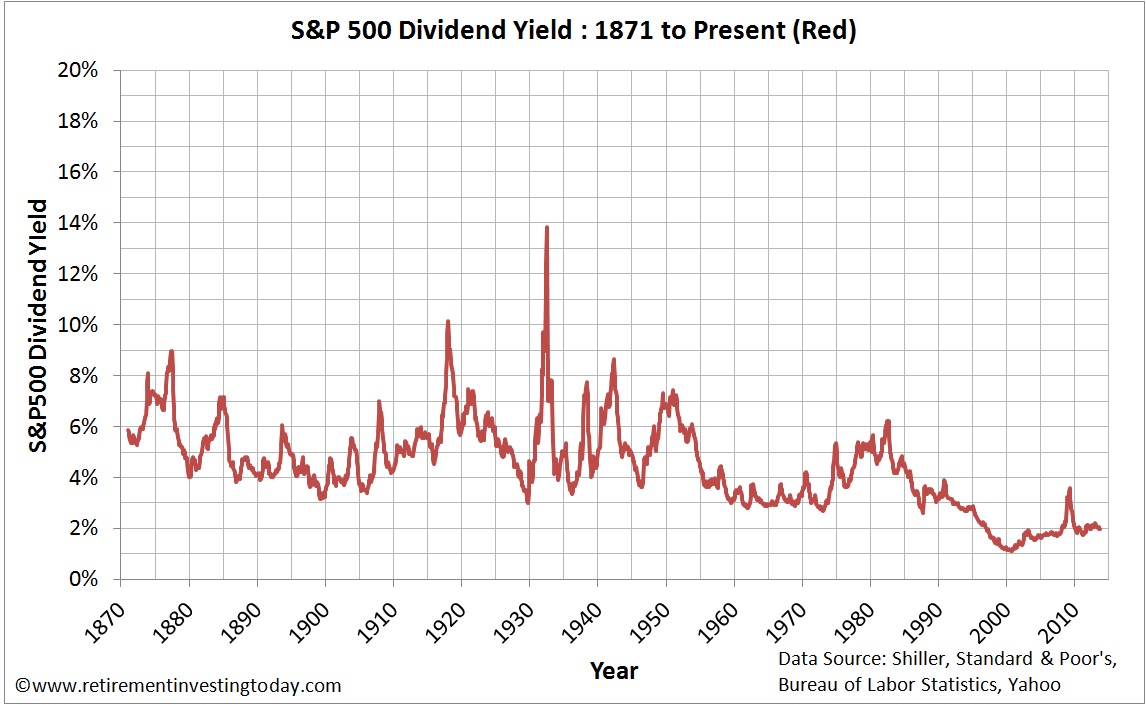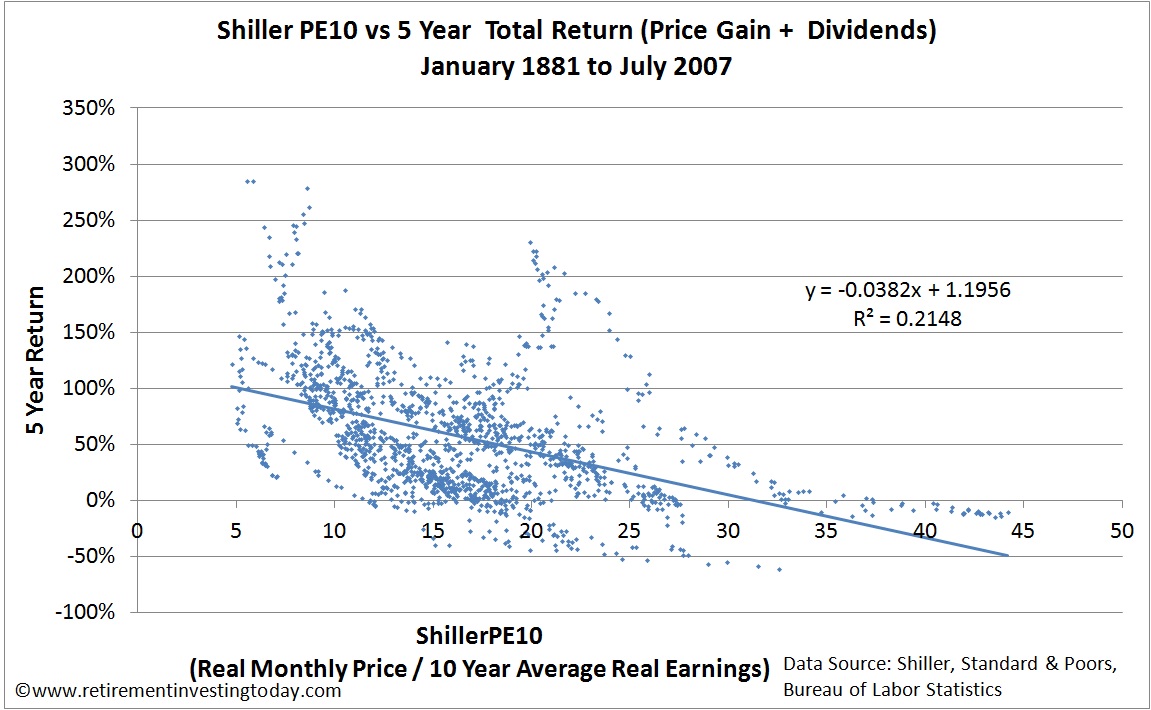This is the monthly review of the S&P500 including a couple of S&P 500 valuation metrics. The last review can be found here.
We can then look at how this Price compares to history which is shown in the chart below.
This is a similar chart to that which you will see in many places within the mainstream media when displayed over a long term. It looks sensational and in my opinion isn’t very helpful. Let’s therefore adjust it to the chart below where I try to show what is really going on with Prices. I make two adjustments:
This only tells half of the Earnings story as it is an absolute number and so doesn’t help us with assessing market value. Let’s therefore divide the nominal Earnings by the nominal Price to calculate the Earnings Yield. Today that’s 5.6% and can be compared with history in the chart below.
If we divide Dividends by Price we get the Dividend Yield which is currently a lowly 2.0% and can be compared with history below.
Personally I prefer to use the S&P500 CAPE. It was made famous by Professor Robert Shiller and is the ratio of Real (ie after inflation) S&P 500 Monthly Prices to 10 Year Real (ie after inflation) Average Earnings. It is also important to highlight that my calculation method varies from that of Professor Shiller. He only uses S&P 500 Actual Earnings data where because I use the S&P 500 CAPE to make investment decisions from I also include extrapolated Earnings estimates right up to the present day. This is to try and make the valuation as current as possible.
So what is the CAPE trying to achieve? We know that we live in a society where boom and bust prevails and the CAPE is simply trying to smooth out the boom and busts to help identify when value is with us. Today the S&P500 CAPE sits at 23.6 which is up on last month’s 23.4.
Both valuation metrics are shown in the chart below.
Does it work? Well only time will tell but what I can say is that history suggests it has some value. If we look at a history of 5 Year Nominal Total Return (Capital Gain + Dividends) of the S&P500 and compare that with the two valuation metrics we find:
A chart showing this CAPE to 5 Year Total Return is shown below. With the CAPE at 23.6 the trendline implies a person buying today could expect a future Nominal 5 Year Total Return of around 30%.
Some other CAPE metrics that may be of interest:
As always do your own research.
Assumptions include:
S&P500 Price
At market close on Friday the S&P500 was Priced at 1,691. That is a rise of 1.4% when compared with 1,669, which is the average closing Price of each trading day last month. It is 20.5% above last year’s August monthly Price of 1,403. Note that for this index I only look at monthly average Prices as opposed to hourly or daily as I’m a very long term investor and just don’t need the noise associated with more granularity. I’ll leave that for the traders out there.We can then look at how this Price compares to history which is shown in the chart below.
Click to enlarge
This is a similar chart to that which you will see in many places within the mainstream media when displayed over a long term. It looks sensational and in my opinion isn’t very helpful. Let’s therefore adjust it to the chart below where I try to show what is really going on with Prices. I make two adjustments:
- Correct the chart for the devaluation of the US Dollar through inflation.
- Show the Pricing on a logarithmic scale as opposed to a linear one. By using this scale percentage changes in price appear the same. For example let’s say we have two historic prices of 10 and 100. If they both increase in price by 10% then they increase by 1 and 10 respectively. On a linear scale it would appear as though the second has increased by a factor of 10 more than the first where on a logarithmic scale they will appear to have changes the same. Less sensational but more correct.
Click to enlarge
S&P500 Earnings
As Reported Nominal Annual Earnings (using a combination of actual and estimated earnings) are currently $94.59. That compares with this time last year at $86.97 implying earnings growth of 8.8% year on year. Or course this looks better than it really is as inflation flatters the result. I therefore plot a chart below, again on a logarithmic axis, showing Real (inflation adjusted) Earnings performance over the long term.
Click to enlarge
This only tells half of the Earnings story as it is an absolute number and so doesn’t help us with assessing market value. Let’s therefore divide the nominal Earnings by the nominal Price to calculate the Earnings Yield. Today that’s 5.6% and can be compared with history in the chart below.
Click to enlarge
S&P500 Dividends
Dividends matter. Today annual dividends for the S&P500 are at $33.27. The Real inflation adjusted growth of S&P500 Dividends, which is what many long term buy and holders including myself are looking for, can be seen in the chart below.
Click to enlarge
If we divide Dividends by Price we get the Dividend Yield which is currently a lowly 2.0% and can be compared with history below.
Click to enlarge
Valuing the S&P500 – The Price/Earnings Ratio (P/E or PE) and the Cyclically Adjusted Price/Earnings Ratio (aka Shiller PE, PE10 or CAPE)
Many people use the S&P500 P/E as a valuation metric. It’s actually nothing more than the inverse of the Earnings Yield shown above. Today it sits at 17.9 which is down on last month’s 18.0.Personally I prefer to use the S&P500 CAPE. It was made famous by Professor Robert Shiller and is the ratio of Real (ie after inflation) S&P 500 Monthly Prices to 10 Year Real (ie after inflation) Average Earnings. It is also important to highlight that my calculation method varies from that of Professor Shiller. He only uses S&P 500 Actual Earnings data where because I use the S&P 500 CAPE to make investment decisions from I also include extrapolated Earnings estimates right up to the present day. This is to try and make the valuation as current as possible.
So what is the CAPE trying to achieve? We know that we live in a society where boom and bust prevails and the CAPE is simply trying to smooth out the boom and busts to help identify when value is with us. Today the S&P500 CAPE sits at 23.6 which is up on last month’s 23.4.
Both valuation metrics are shown in the chart below.
Click to enlarge
Does it work? Well only time will tell but what I can say is that history suggests it has some value. If we look at a history of 5 Year Nominal Total Return (Capital Gain + Dividends) of the S&P500 and compare that with the two valuation metrics we find:
- The P/E has a correlation of -0.32 which is considered a weak or low correlation.
- The CAPE has a correlation of -0.46 which is considered a moderate correlation. So it’s not perfect but it’s better than P/E when looking over longish periods which suits an investor like me.
A chart showing this CAPE to 5 Year Total Return is shown below. With the CAPE at 23.6 the trendline implies a person buying today could expect a future Nominal 5 Year Total Return of around 30%.
Click to enlarge
Some other CAPE metrics that may be of interest:
- The correlation between the Nominal S&P500 Price and the S&P 500 PE10 from present day back to 1881 is 0.66. That is also considered moderate and is another reason I use this metric to make investment decisions from.
- The Dataset Average S&P 500 PE10 which dates back to 1881 is 16.5. Assuming this is “fair value” it indicates that the S&P500 is now some 43% overvalued.
- The Dataset Median S&P PE10 is 15.9.
- The Dataset 20th Percentile S&P 500 PE10 is 11.1.
- The Dataset 80th Percentile S&P 500 PE10 is 21.0 which we are well above today.
Making Personal Investment Decisions from this Data
My Retirement Investing Today Strategy drives tactical allocations from CAPE values. It uses the S&P500 CAPE to set my allocation to the International Equities portion of my portfolio. This is strategically set at 15% of total assets and is targeted to consist of 40% US Equities, 40% Europe Equities and 20% Japan Equities. I then add the S&P500 CAPE tactical spin on top of this with a target of 10.5% allocation should the PE10 climb to 26.5 (Average PE10+10) or 19.5% should the PE10 fall to 6.5 (Average PE10-10). Therefore today my tactical allocation sets itself below 15% at 11.8%.As always do your own research.
Assumptions include:
- S&P500 Prices are month averages except August 2013 which is the 09 August 2013 market close Price.
- July and August 2013 Dividends are assumed to be equal to the June 2013 Dividend.
- April to August 2013 As Reported Earnings are estimates from Standard & Poor’s.
- Inflation data from the Bureau of Labor Statistics. July and August 2013 inflation is extrapolated.
- Historic data provided from Professor Shiller website.









Bravo, you analysis continues to impress.
ReplyDeleteYou're saving for a very early retirement . Fair enough; but that means that your retirement could last for four or five decades. How do you propose to invest then?
ReplyDeleteYou still have a multi-million dollar portfolio that needs reallocating even in retirement...
Delete